Washington, D.C., the capital of the United States, is renowned for its historical monuments, iconic landmarks, and vibrant cultural scene. But beyond the well-trodden tourist paths, DC boasts another treasure: an extensive network of bike paths perfect for both recreation and commuting. These bike paths in DC offer a unique way to experience the city, connecting communities, green spaces, and historical sites.
Washington D.C.’s commitment to creating a bike-friendly city is evident in initiatives like the Capital Trails Coalition, aiming to link the entire metropolitan region with an 800-mile trail network. Whether you’re a local resident or a visitor, exploring DC’s bike paths opens up a world of outdoor adventures and urban exploration. Let’s dive into the top 10 Bike Paths Dc has to offer, each promising a distinct and memorable journey.
1. Metropolitan Branch Trail: A Capital City Connector
 Cyclists and pedestrians enjoy the Metropolitan Branch Trail in Washington, D.C.
Cyclists and pedestrians enjoy the Metropolitan Branch Trail in Washington, D.C.
The Metropolitan Branch Trail (MBT) is quickly becoming a vital artery for bike paths in DC. This developing 8-mile trail, designed to eventually link Union Station in DC with Silver Spring, Maryland, already serves thousands of daily commuters and recreational cyclists. As a key bike path DC residents rely on, the MBT weaves through historically rich and rapidly evolving neighborhoods such as NoMa, Eckington, Edgewood, and Brookland.
Following the path of the former Baltimore and Ohio Railroad’s Metropolitan Branch rail line, this bustling rail-with-trail runs parallel to four active rail lines, including Metro’s Red Line, MARC commuter service, CSX, and Amtrak. Along this popular bike path DC cyclists can appreciate public art installations, including vibrant rotating murals, and enjoy access to green spaces like the recently inaugurated Alethia Tanner Park. The Arts Walk at Monroe Street Market, with its galleries, studios, and eateries, offers a perfect mid-ride stop. Future plans for this crucial bike path in DC include connecting it to the Capital Crescent Trail in Silver Spring, further expanding the network of bike paths DC offers.
2. Rock Creek Park Trails: Nature in the Urban Heart
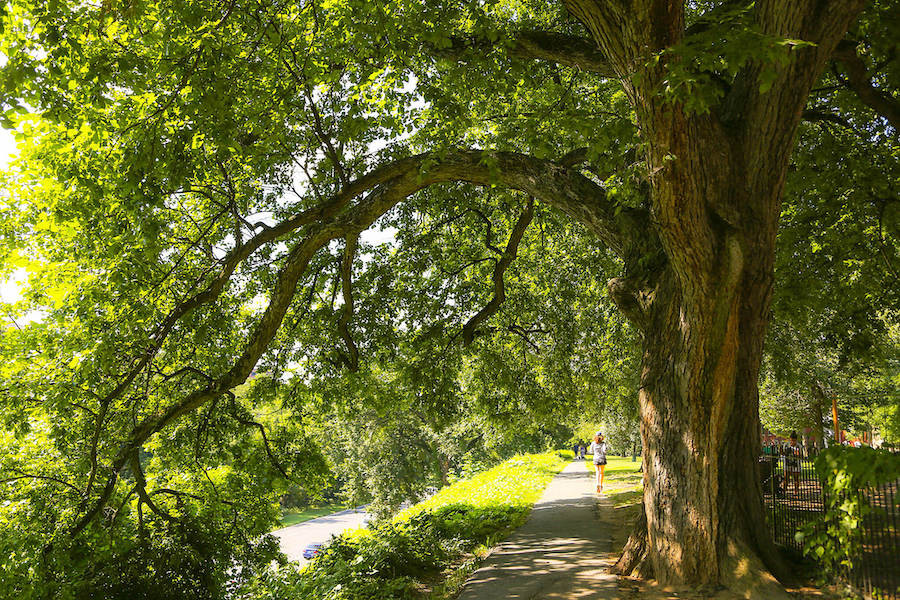 A cyclist rides along a paved path surrounded by lush greenery in Rock Creek Park, Washington, D.C.
A cyclist rides along a paved path surrounded by lush greenery in Rock Creek Park, Washington, D.C.
Established in 1890 as America’s oldest urban national park, Rock Creek Park is a green sanctuary offering over 1,700 acres of natural beauty and over 32 miles of trails perfect for hiking and biking. Among these, an 8.5-mile paved pathway stands out as a premier bike path DC enthusiasts adore. This trail runs parallel to Beach Drive and Oregon Avenue, loosely following Rock Creek in two main sections between I-66 and the Maryland border.
More than just bike paths DC residents can use, Rock Creek Park offers a plethora of activities, including picnicking, boating, and even horseback riding. History buffs will appreciate the park’s visitor centers, including a Nature Center and Planetarium, an 18th-century mill, and the Old Stone House in Georgetown. Rock Creek Park Trails also form part of the ambitious Great American Rail-Trail™, a 3,700-mile route connecting Washington, D.C., to Washington State, making it a significant piece of the larger bike paths DC and the nation have to offer.
3. National Mall Trails: Iconic Views on Two Wheels
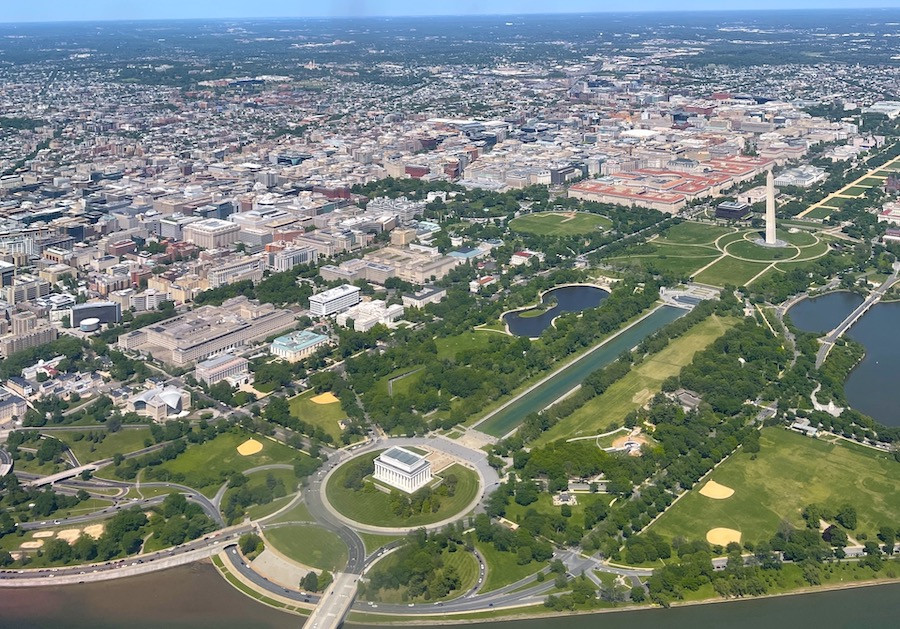 Cyclists ride past the Washington Monument on the National Mall in Washington, D.C.
Cyclists ride past the Washington Monument on the National Mall in Washington, D.C.
The National Mall and Memorial Parks, a globally recognized landmark, is not just for walking; it’s also home to some of the most iconic bike paths DC offers. This park, visited by millions annually, features over 100 monuments and memorials honoring American history and heritage.
The tree-lined mall itself comprises a series of interconnected, largely pedestrian-friendly pathways stretching about 2 miles long and 0.3 miles wide, covering over 1,000 acres. These walkways serve as exceptional bike paths DC visitors and locals can use to connect iconic sites like the Washington, Lincoln, and Martin Luther King, Jr. memorials, the White House, and the U.S. Capitol Building. They also provide access to renowned museums like the National Gallery of Art and the Smithsonian Institution complex. During the National Cherry Blossom Festival, these bike paths DC transforms, becoming a central part of the festivities. The National Mall Trails also represent the easternmost section of the Great American Rail-Trail, solidifying its place in the network of bike paths DC and beyond.
4. Anacostia River Trail: Exploring DC’s Waterfront
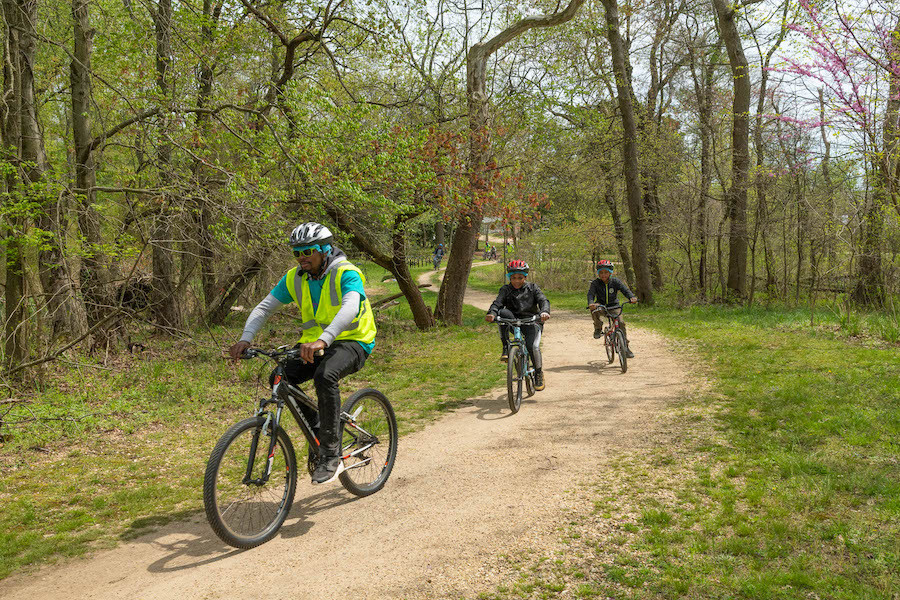 A cyclist pauses on the Anacostia River Trail with the river and greenery visible in Washington, D.C.
A cyclist pauses on the Anacostia River Trail with the river and greenery visible in Washington, D.C.
The Anacostia River Trail is an evolving 20-mile gem among bike paths in DC, with approximately 12 miles currently developed on both sides of the Anacostia River. This trail is set to connect 16 neighborhoods in the DC area, providing crucial links and recreational opportunities. The paved path meanders through riverside woodlands, marshlands, urban developments, and parkland, showcasing the diverse landscapes DC has to offer.
Along the Anacostia Riverfront, users of these bike paths DC can access community centers, playgrounds, sports fields, and a roller skating pavilion. The trail already connects major DC destinations such as Nationals Park, Diamond Teague Park, historic Navy Yard, and Kenilworth Aquatic Gardens. Future expansions will link it to the Tidal Basin and the National Mall, enhancing the connectivity of bike paths DC offers. The Anacostia River Trail also connects to the Northwest Branch Trail and the Northeast Branch Trail in Maryland, extending the biking experience beyond DC’s borders.
5. Klingle Valley Trail: A Short but Scenic Escape
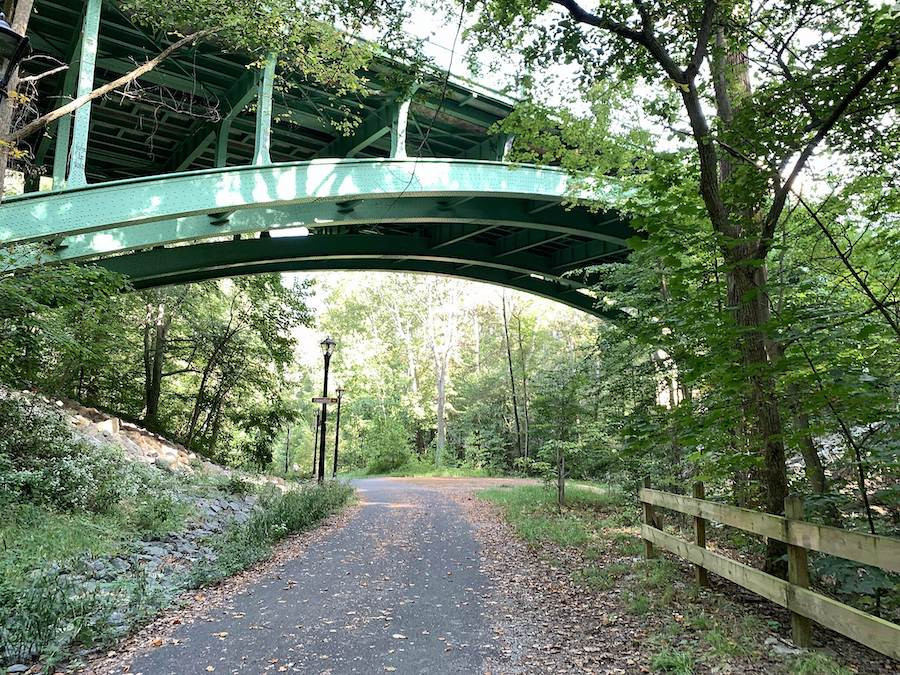 A cyclist rides on the Klingle Valley Trail through a tree-lined area in Washington, D.C.
A cyclist rides on the Klingle Valley Trail through a tree-lined area in Washington, D.C.
The Klingle Valley Trail is a 0.7-mile treasure, often described as a hidden gem among bike paths DC provides. Nestled in a tree-lined residential area of northwest DC, this paved trail, opened in 2017, bisects the Klingle Valley, crossing Rock Creek Park just north of the National Zoo.
Serving the communities of Cleveland Park, Woodley Park, and Mount Pleasant, this bike path DC follows a former roadway that was heavily damaged by floods in 1991. The trail offers a connection to the Tregaron Conservancy, a historic woodland park with its own network of trails and gardens, providing an escape within the urban environment. The Klingle Valley Trail project also incorporated significant restoration features for the Klingle Creek area, highlighting the environmental benefits of bike paths DC builds.
6. Chesapeake & Ohio Canal National Historical Park: Ride Through History
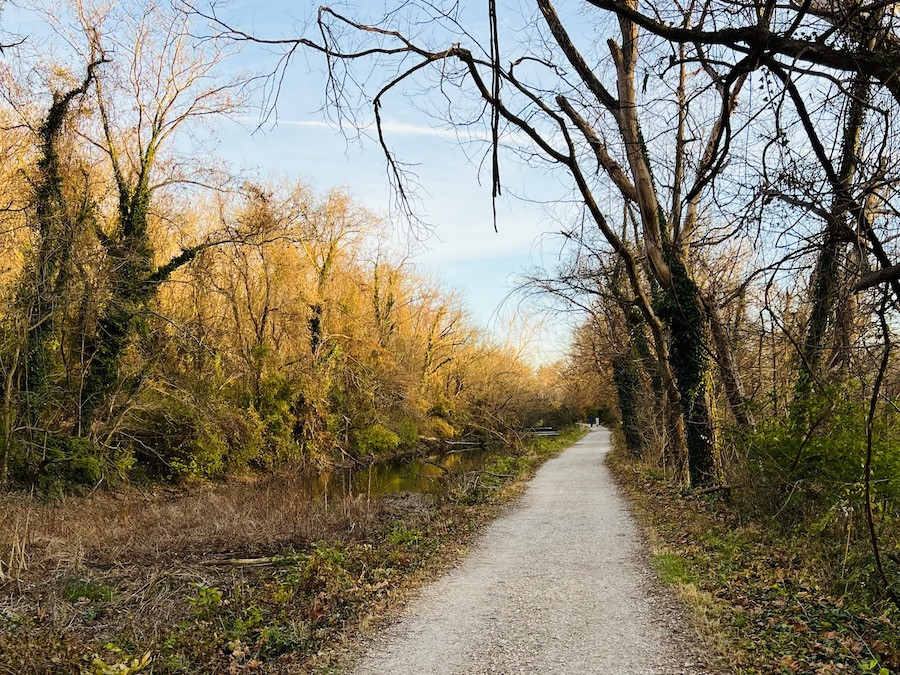 A cyclist rides along the C&O Canal Towpath with the canal and trees alongside in Washington, D.C.
A cyclist rides along the C&O Canal Towpath with the canal and trees alongside in Washington, D.C.
Steeped in history dating back to George Washington, the Chesapeake & Ohio Canal National Historical Park, often referred to as the C&O Canal Towpath, offers 184.5 miles of trails, starting near the National Mall and extending to Cumberland, Maryland. This historic route is more than just one of the bike paths DC has; it’s a journey through American heritage.
Once a vital commercial transportation route, the C&O Canal Towpath now serves as a landscape for recreation, active transportation, and outdoor tourism. This bike path DC and Maryland residents cherish features original Canal Era structures like locks, lock houses, and aqueducts. It also played a role in the American Civil War. In Cumberland, this trail connects with the Great Allegheny Passage, forming a continuous 334.5-mile route to Pittsburgh, attracting cyclists worldwide. The C&O Canal Towpath is also part of the September 11th National Memorial Trail and the Great American Rail-Trail, making it a central hub in the network of bike paths DC is connected to.
7. Capital Crescent Trail: A Premier Commuting and Recreation Route
 Cyclists and pedestrians share the Capital Crescent Trail in a wooded area in Washington, D.C.
Cyclists and pedestrians share the Capital Crescent Trail in a wooded area in Washington, D.C.
Serving over a million users annually, the Capital Crescent Trail is a leading bike path DC offers, ideal for both commuting and recreation. This trail connects Silver Spring, Maryland, with historic Georgetown in DC, following a crescent-shaped route with scenic waterside views, wildlife, parkland, and cultural sites.
In Georgetown and Silver Spring, the Capital Crescent Trail links to Rock Creek Park, expanding access to more bike paths DC area offers. In DC, the trail runs along the Potomac River and the C&O Canal Towpath, passing attractions like the National Zoo and the Kennedy Center. Created through community advocacy in the 1980s, this trail now serves as a gateway bike path DC uses to connect to the Great American Rail-Trail.
8. Oxon Run Trail: A Best-Kept Secret for Local Cyclists
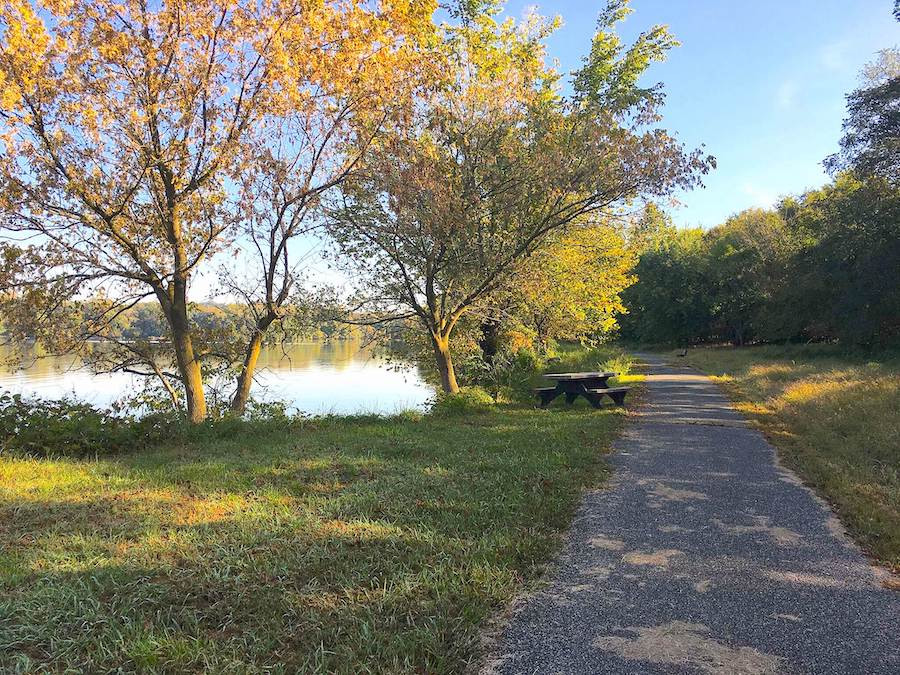 A paved section of the Oxon Run Trail winds through a green area in Washington, D.C.
A paved section of the Oxon Run Trail winds through a green area in Washington, D.C.
The Oxon Run Trail, praised as a “best-kept secret” and a “great trail” by TrailLink.com™ reviewers, offers a 3.4-mile route along the Oxon Run tributary in Oxon Run National Parkway. This trail is divided into two sections in southeast DC and Prince George’s County, Maryland, providing valuable outdoor space in a trail-scarce area.
This bike path DC residents appreciate has been recently upgraded with new asphalt, wider paths, and improved lighting. Future plans include extending the trail by 4.8 miles and connecting it with the planned Oxon Cove Hiker-Biker Trail and the South Capitol Trail, further enhancing the network of bike paths DC is developing.
9. Fort Circle Park Hiker-Biker Trail: History and Nature Combined
 A paved path, part of the Fort Circle Park Hiker-Biker Trail, goes through a wooded area in Washington, D.C.
A paved path, part of the Fort Circle Park Hiker-Biker Trail, goes through a wooded area in Washington, D.C.
Historically significant yet understated, the 7-mile Fort Circle Park Hiker-Biker Trail runs through a forested area between Fort Mahan and Fort Stanton, linking numerous Civil War-era forts, many of which are now national parks. This trail provides a unique historical dimension to bike paths DC offers.
A significant portion of the trail passes through Fort Dupont Park, a 376-acre green space that was once the site of a Civil War-era fort. Today, Fort Dupont Park offers nature walks, picnics, concerts, and Civil War programs. While the fort itself is gone, its earthworks remain, and the area’s history as a haven for enslaved people adds depth to this route among bike paths DC provides. Note that this trail can feel rural and includes road crossings, with hiking or mountain biking recommended due to potential overgrowth and muddy conditions.
10. Marvin Gaye Trail: A Musical Journey Through DC Neighborhoods
 The Marvin Gaye Trail in Washington, D.C., winds through a park with trees and greenery.
The Marvin Gaye Trail in Washington, D.C., winds through a park with trees and greenery.
Named in honor of the legendary musician Marvin Gaye, who grew up in DC, the Marvin Gaye Trail is a nearly 2-mile bike path DC residents enjoy. It stretches from Minnesota Avenue to 61st Street, NE, traversing Marvin Gaye Park, DC’s longest municipal park, and loosely parallels Watts Branch Stream.
This bike path DC trail passes through the Deanwood, Burville, Lincoln Heights, and Hillbrook neighborhoods, providing safe access to recreational opportunities, schools, shopping, and restaurants. Marvin Gaye Recreation Center, located at the trail’s east end, offers sports facilities. The revitalized green space along the trail includes gardens and performance areas. A mosaic of Marvin Gaye marks the entrance to Lady Bird Johnson Meadows at the park’s western end, adding a cultural touch to these bike paths DC has created.
Explore More Bike Paths in DC
Washington, D.C.’s bike paths offer something for everyone, from history buffs and nature lovers to urban explorers and daily commuters. These top 10 trails are just the beginning. Discover even more bike paths DC has on offer and experience the capital in a whole new way – on two wheels!


